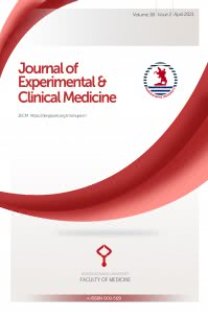Çalışanlarda yüzeyel mikoz prevalansı ve etken mantarların belirlenmesi
Candida, Candida albicans, Kandidiyaz, Dermatomikozlar, Arthrodermataceae, Tanı, Malassezia, Tinea pedis, Trichophyton, Yaygınlık
Determine of superficial mycoses prevalence and causative pathogens at workers
Candida, Candida albicans, Candidiasis, Dermatomycoses, Arthrodermataceae, Diagnosis, Malassezia, Tinea Pedis, Trichophyton, Prevalence,
___
1. Schmutz JL, Barbaud A, Conlet-Audonneau N. Superficial mucoculaneous mycosis. Rev PraL 1996; 46: 1617-22.2. Kuştimur S, El-Nahi H. Ankara'nın Balgat ve çevresindeki yerleşim bölgelerinden izole edilen dermatomikoz etkenleri. Türk Mikrobiyol Cem Derg 1993; 23: 116-118.
3. Elewski BE. Onychomycosis: Palhogenesis, Diagnosis, and Management. Clin Microbiol Rev 1998; 11: 415-429.
4. Sürücüoglu S, Türker M, Üremek H ve ark. İzmir bölgesinde yüzeysel mantar infeksiyonuna neden olan 660 dermatofit ve maya türünün değerlendirilmesi. İnfeks Derg 1997; 11: 63-65.
5. Tümbay E. Pratik Tıp Mikolojisi. 1. Baskı. İzmir, Bilgehan Basımevi 1983.
6. Yücel A. Tıp bakımından önemli Candida türlerinin mikolojisi. Türk Mikrobiyol Cem Derg 1987; 17: 45-48.
7. Tillon RC, Mc Ginnis MR. Dermatophytes. in: Howard BJ (Ed). Clinical and Pathogenic Microbiology (first ed). Washington DC, The CV Mosby Co,. 1987; 563-574.
8. Saniç A. Günaydın M, Durupmar B ve ark. Samsun ve çevresinde dermatofitozlar. Mikrobiyol Bült 1996: 30: 57-63.
9. Devliotou PD, Koussidou ET, Badillet G. Denna lophy losis in nothern Greece during the decade 1981-1990. Mycoses 1995; 38(3-4): 151-157.
10. Canleros CE. Davel GO, Vivot W, et. al. Incidence of various ecologic agents of superficial mycosis. Rev Argent Microbiol 1993; 25: 129-135.
11. Dal Tio R, Lunardi M. Prevalence of superficial mycoses in the Aoste Valley region of Raly from 1984 Lo 1989. Mycopathologia 1991; 116: 155-158.
12. Ay S. Yılmaz M. Fırat Üniversitesi Haslanesi'nde bir yılda izole edilen onikomikoz etkeni dermatofit ve mayalar, Infeks Derg 1998; 12: 213-216.
13. Yegenoğlu Y. Son 1 yılda kliniğimizde onikomikoz etkeni olarak saplanan mayalar. Türk Mikrobiyol Cem Derg 1991; 2: 371.
14. Midgley G, Moore MK, Cook JC. eL al. Mycology of nail disorders. J Am Acad Dermatol 1994: 3K3P12): 68-74.
15. Aly R. Ecology and epidemiology dermalophyte infections. J Am Acad Dermatol 1994; 31(3Pt2): 21-25.
16. Kölemen F. Dermatofitlerin yaş, cins ve anatomik bölgelere göre dağılımı. Lepra Mec 1978; 1: 64-69.
17. Öztürkcan S, Yalçın N. Akıncı S ve ark. Son 3 yılda kliniğimizde onikomikoz etkeni olarak sapladığımız mantarlar. Mikrobiyol Bült 1994; 28: 345-351.
18. Evron R. Ganor S, Wax Y, et al. Epidemiological trends of dermatophyloses and dermatophytes in Jerusalem between 1954 and 1981. Mycopathologia 1985; 90: 113-120.
19. Kemna ME, Elewsld BE. A.U.S. epidemiologic survey of superficial fungal diseases. J Am Acad Dermatol 1996; 35: 539-542.
20. Temizerler H, Sabuncu İ. Eskişehir ve çevresinin dermatofitik florası. Anadolu Tıp Dergisi 1982; 4: 131-142.
21. Bridger RC. Superficial mycoses in a southern New Zealand district. Saboraudia 1979; 17(2): 107-112.
22. Şahin M, Yuluğ N. The fungi causing superficial mycoses found in and around Ankara. Mikrobiyol Bult 1977; 11(1): 35-43.
23. Kuijpers AF, Tan CS. Fungi and yeasts isolated in mycological studies in skin and nail infeetions in The Netherlands, 1992-1993. Ned Tijdschr Geneeskd 1996; 140(19): 1022-1025.
24. Rippon JW. The changing epidemiology and emerging patterns of dermatophyte species. Curr Top Med Mycol 1985; 1: 208-234.
25. Mc Aleer R. Fungal infections of the nails in Western Australia. Mycopathologia 1981; 73(2): 115-120.
26. Ayanbimpe GH, Bello CS, Gugnani HC. The aetiological agents of superficial cutaneous mycoses in Jos. Plateau State of Nigeria. Mycoses 1995; 38 (5-6): 235-237.
27. Marufi M, Özçelik S, Köylüoğlu Z. Sivas Bölgesinde değişik dermatozlar İçinde yüzeysel mantar infeksiyonlarının insidansı. İnfeks Derg 1990; 4: 117.
- ISSN: 1300-2996
- Yayın Aralığı: Yılda 4 Sayı
- Başlangıç: 2018
Bakan Nurten AKPOLAT, Tülin GÜMÜŞ, Ülkü AYPAR, Elif BAŞGÜL, MERAL KANBAK, Kemal ERDEM
Soliter pulmoner nodüllerin malign-benign ayrımında dinamik kontrastlı BT incelemesi
Murat DANACI, Hüseyin AKAN, Ümit BELET, Lütfi İNCESU, Murat BAŞTEMİR, Mustafa Bekir SELÇUK
Hodgkin dışı lenfomalı olgularda Ca-125 düzeyinin değerlendirilmesi
Mustafa KETENCİ, İdris YÜCEL, Murat TOPBAŞ
Çalışanlarda yüzeyel mikoz prevalansı ve etken mantarların belirlenmesi
Ayhan PEKBAY, Ahmet SANIÇ, Ayla YENİGÜN, BORA EKİNCİ, Satı ATİLLA, Evren KOSİF, Figen ÖZCAN
Toksoplazma antikorlarının Samsun yöresinde seroprevalansının araştırılması
Murat HÖKELEK, Yavuz UYAR, Murat GÜNAYDIN, Meryem ÇETİN
Kallus distraksiyon yöntemi ile alt ekstremite uzatma sonuçları
YILMAZ TOMAK, Nevzat DABAK, T. Nedim KARAİSMAİLOĞLU, Mustafa KARA, Hakan ÖZCAN
